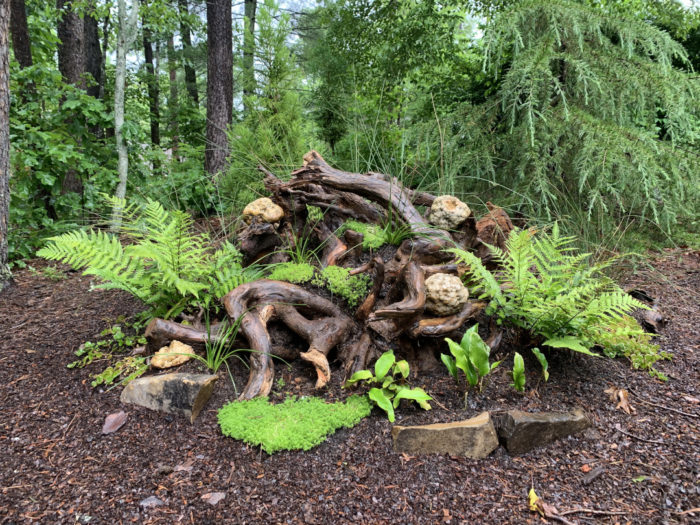
Today we’re visiting with Bonnie Plikaytis and her stumperies.
My husband and I live in Big Canoe, a woodland community in north Georgia. I have been gardening this acre of land in Zone 7 for the past seven years. In 2018, we visited the stumpery at the Rhododendron Species Botanical Garden just south of Seattle in Federal Way, Washington. A stumpery is an arrangement of woody material like trunks and root wads (root balls) to create a habitat for ferns and companion plants. The woody material is arranged in an aesthetically pleasing form to create pockets conducive to the growth of the intended plants. Since I live in a woodland area with lots of woody debris, it seemed only natural to build a stumpery or two myself.
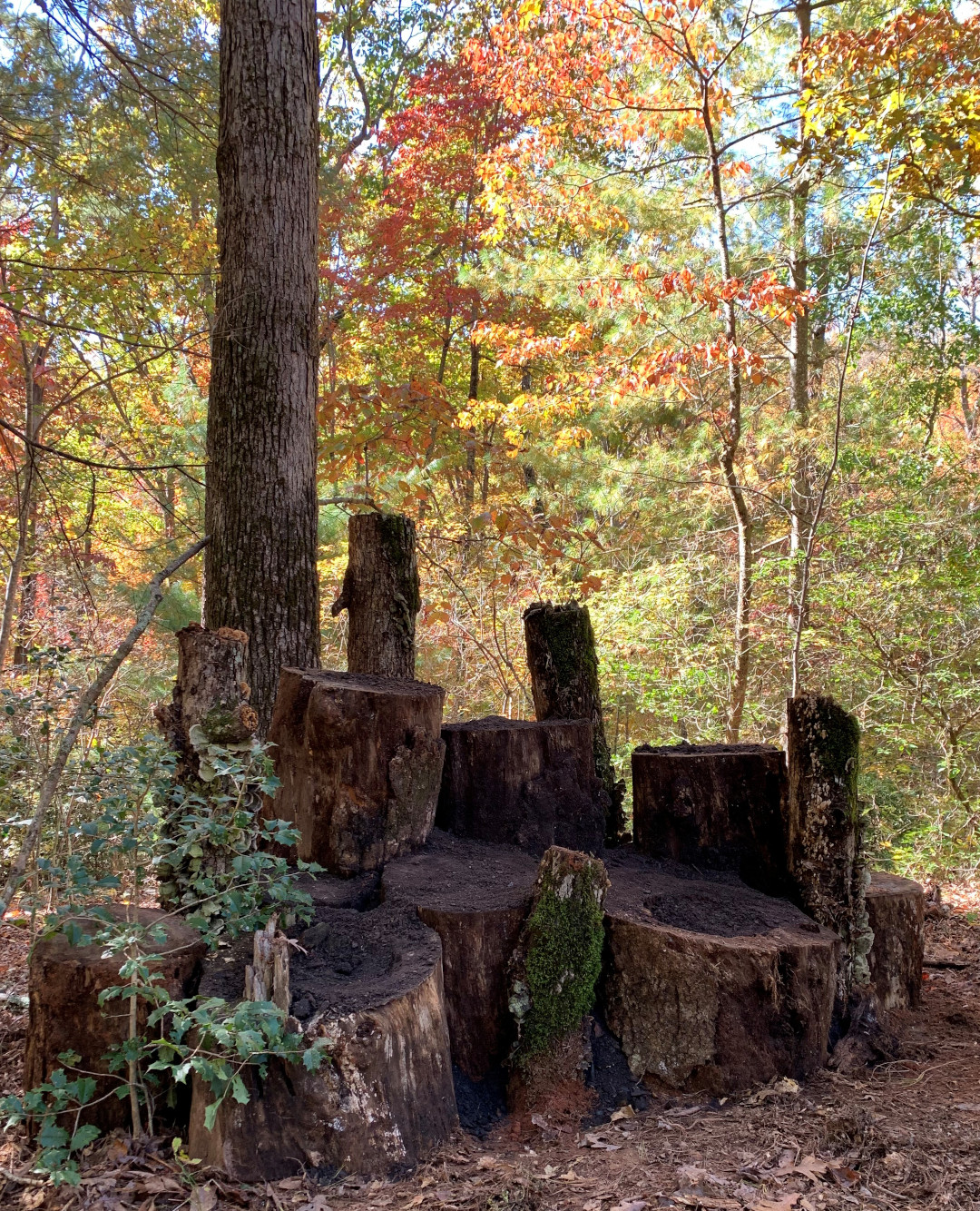 The first stumpery was built in November 2018 of logs from a large downed oak tree. The gentleman and crew that does the rock work in our garden arranged the large, heavy logs in a structurally sound manner. Once the logs were in place, I filled the hollow logs and crevices between the logs with raised-bed soil.
The first stumpery was built in November 2018 of logs from a large downed oak tree. The gentleman and crew that does the rock work in our garden arranged the large, heavy logs in a structurally sound manner. Once the logs were in place, I filled the hollow logs and crevices between the logs with raised-bed soil.
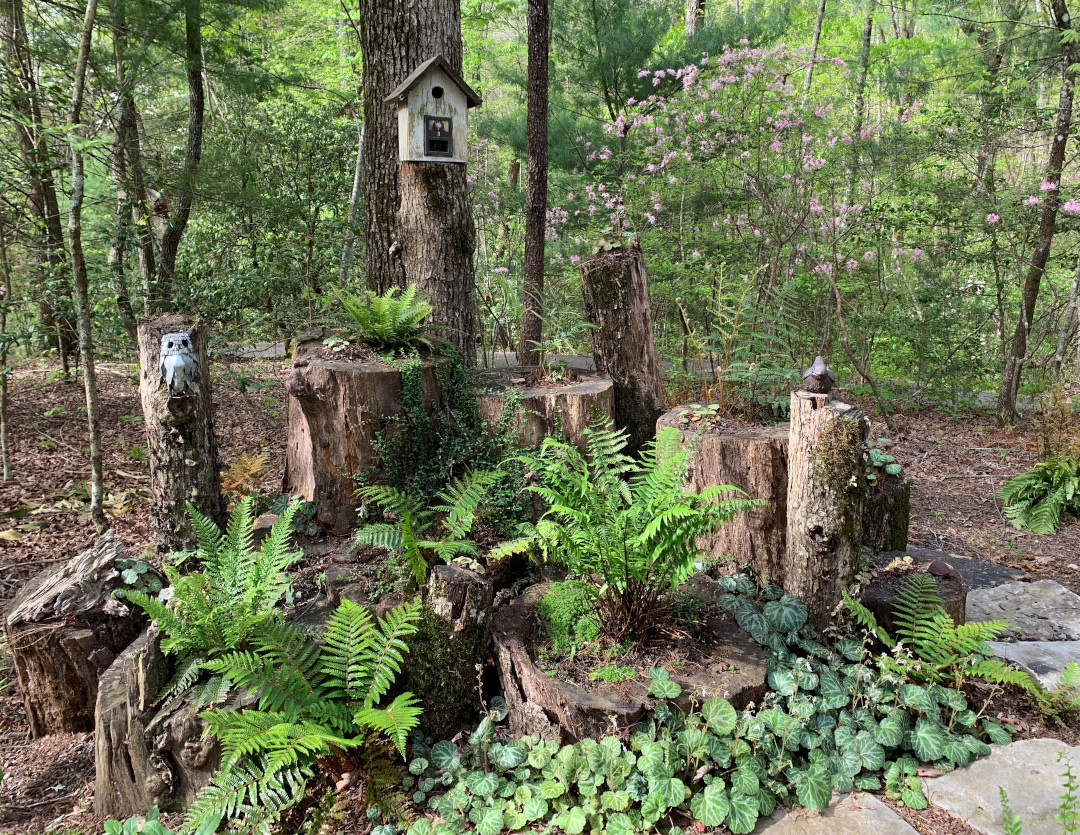 The stumpery was placed in the garden such that in the spring the azaleas native to the property provided a lovely backdrop, as seen in this 2020 spring photo. The evergreen to semi-evergreen ferns in the stumpery include beautiful wood fern (Dryopteris pulcherrimal, Zones 6–9), shaggy shield (Dryopteris cycadina, Zones 5–8), autumn fern (Dryopteris erythrosora, Zones 5–8), tassle fern (Polystichum polyblepharum, Zones 5–8), hard shield fern (Polystichum aculeatum), East Indian holly fern (Arachnoides simplicior, Zones 7–9), and Siebold’s wood fern (Dryopteris sieboldii, Zones 6–8). Companion plants are strawberry geranium (Saxifraga stolonifera, Zones 6–9), moss stonecrop (Sedum acre, Zones 4–9), and miniature wintercreeper (Euonymus fortunei ‘Kewensis’, Zones 4–9).
The stumpery was placed in the garden such that in the spring the azaleas native to the property provided a lovely backdrop, as seen in this 2020 spring photo. The evergreen to semi-evergreen ferns in the stumpery include beautiful wood fern (Dryopteris pulcherrimal, Zones 6–9), shaggy shield (Dryopteris cycadina, Zones 5–8), autumn fern (Dryopteris erythrosora, Zones 5–8), tassle fern (Polystichum polyblepharum, Zones 5–8), hard shield fern (Polystichum aculeatum), East Indian holly fern (Arachnoides simplicior, Zones 7–9), and Siebold’s wood fern (Dryopteris sieboldii, Zones 6–8). Companion plants are strawberry geranium (Saxifraga stolonifera, Zones 6–9), moss stonecrop (Sedum acre, Zones 4–9), and miniature wintercreeper (Euonymus fortunei ‘Kewensis’, Zones 4–9).
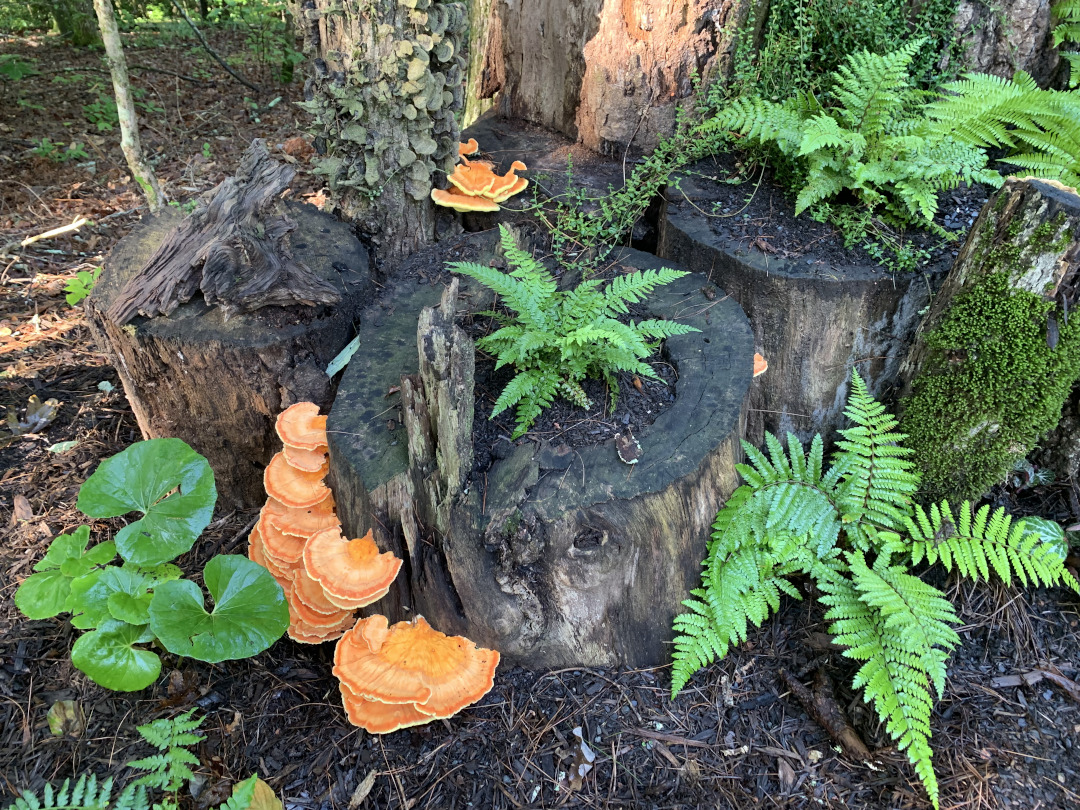 After a week with 7 inches of rain in early June 2019, we were surprised when the stumpery grew chicken-of-the-woods (Laetiporus sulphureus), a bright orange, edible bracket fungus.
After a week with 7 inches of rain in early June 2019, we were surprised when the stumpery grew chicken-of-the-woods (Laetiporus sulphureus), a bright orange, edible bracket fungus.
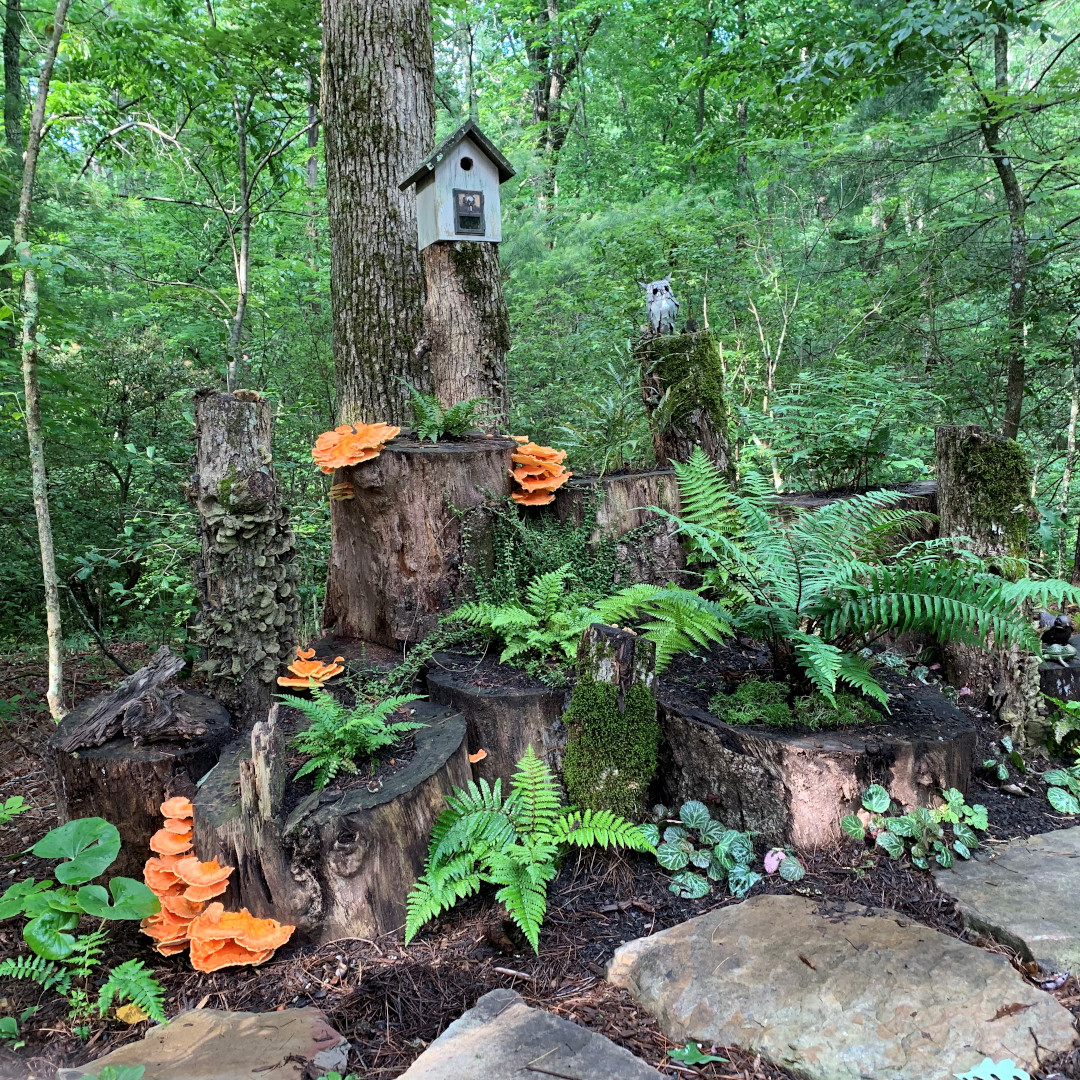 This fungus was a colorful addition to the stumpery for many days.
This fungus was a colorful addition to the stumpery for many days.
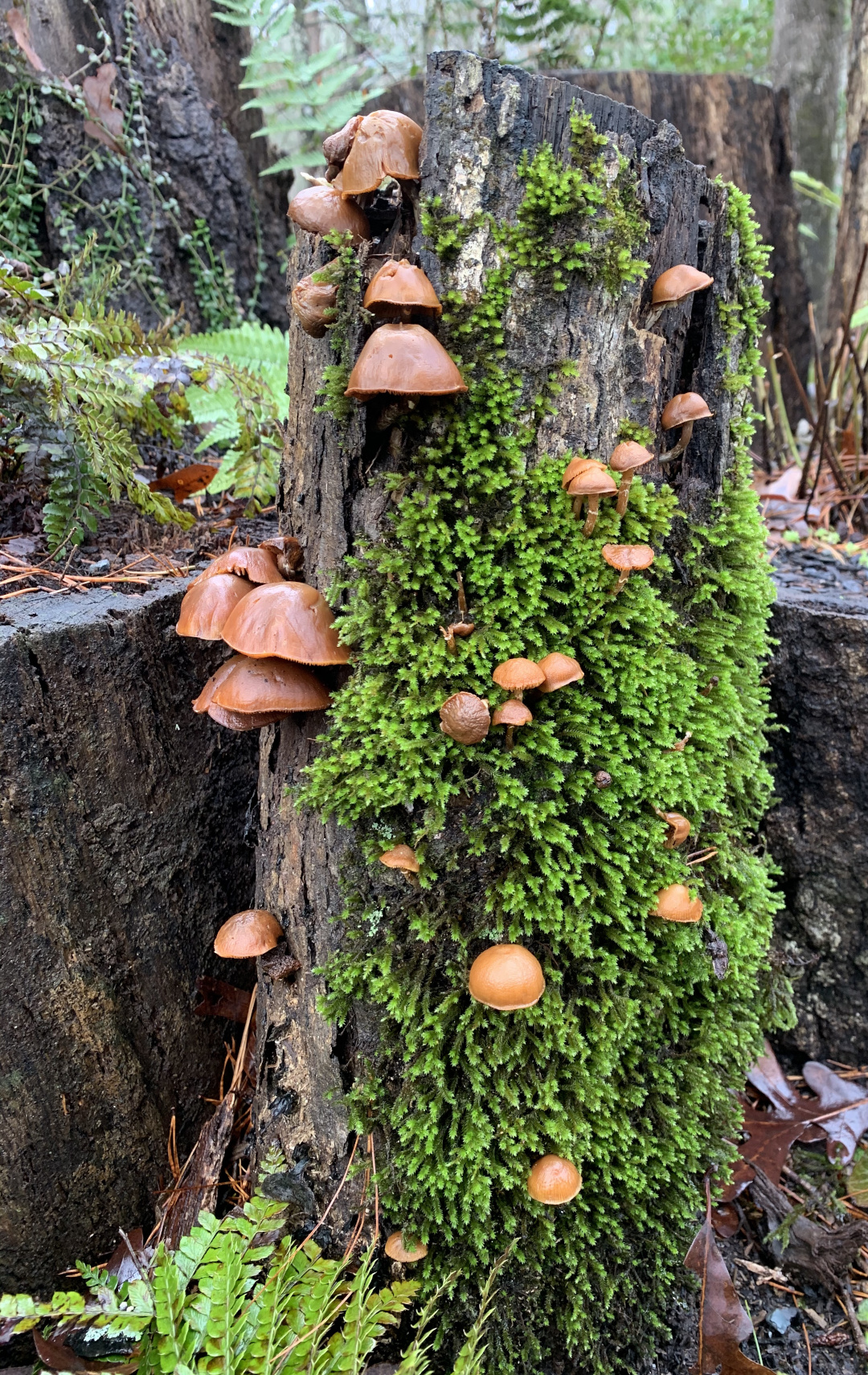 In January 2020 after 6 inches of rain in two days, Galerina marginata appeared on this moss-covered log of the stumpery. Galerina mushrooms contain amatoxins—which cause sickness and vomiting followed eventually by liver damage and, if not treated promptly, death. Though toxic, these mushrooms provided a striking contrast in color and texture to the verdant green moss. These mushrooms disappeared overnight, as quickly as they had appeared.
In January 2020 after 6 inches of rain in two days, Galerina marginata appeared on this moss-covered log of the stumpery. Galerina mushrooms contain amatoxins—which cause sickness and vomiting followed eventually by liver damage and, if not treated promptly, death. Though toxic, these mushrooms provided a striking contrast in color and texture to the verdant green moss. These mushrooms disappeared overnight, as quickly as they had appeared.
 To give a sense of the stumpery in relation to the shade garden in which it resides, this is the view from our deck. The area includes a collection of plants that creates a palette of diverse green hues as well as a variety of forms and textures, which complement the Tennessee fieldstone pathway leading to the stumpery from the garden path.
To give a sense of the stumpery in relation to the shade garden in which it resides, this is the view from our deck. The area includes a collection of plants that creates a palette of diverse green hues as well as a variety of forms and textures, which complement the Tennessee fieldstone pathway leading to the stumpery from the garden path.
This collection of plants includes giant leopard plant (Farfugium japonicum var. giganteum, Zones 7–10), bamboo fern (Coniogramme japonica, Zones 7–9), royal fern (Osmunda regalis, Zones 2–10), variegated Solomon’s seal (Polygonatum odoratum var. pluriflorum ‘Variegatum’, Zones 3–8), sweet flag grass (Acorus gramineus ‘Ogon’, Zones 5–9), ‘Autumn Bride’ heuchera (Heuchera villosa ‘Autumn Bride’, Zones 3–8), and oakleaf hydrangea (Hydrangea quercifolia ‘Snowflake’, Zones 5–9).
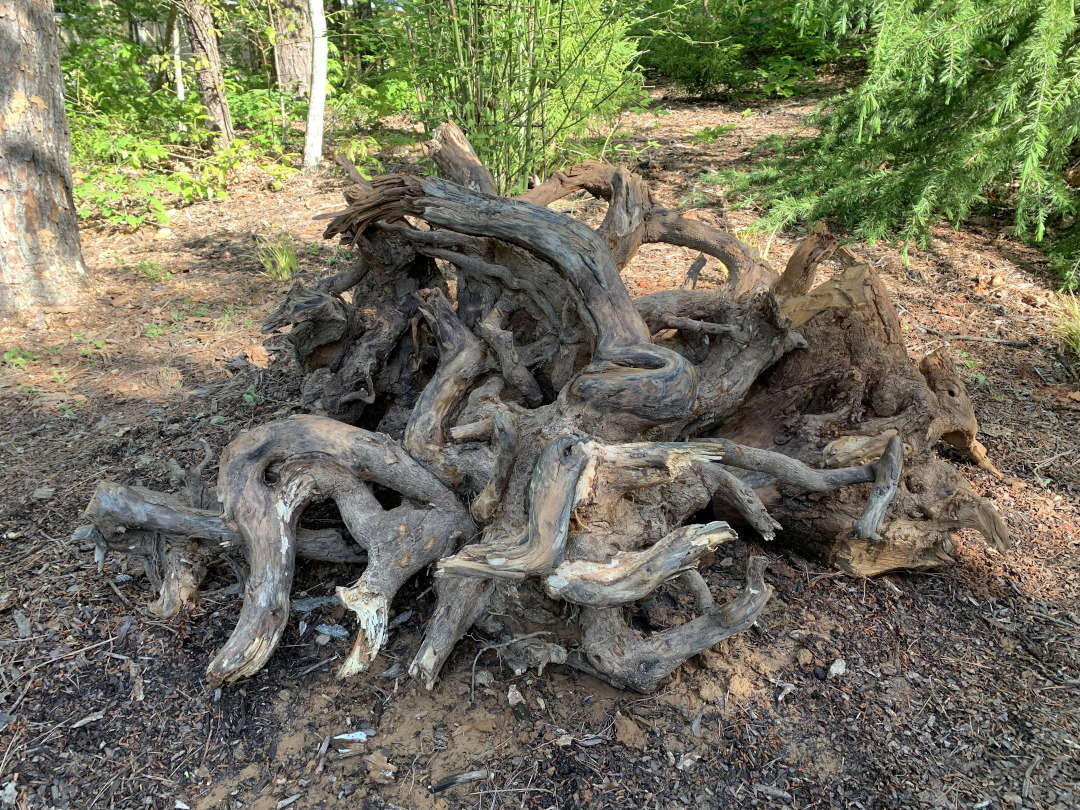 The second stumpery, built in May 2020, has an abstract form. The root wads (balls) were given to us by a neighbor who was cleaning their property. After arranging the root wads, I used water pressure to clear the dirt from some of the roots to enhance the crevices.
The second stumpery, built in May 2020, has an abstract form. The root wads (balls) were given to us by a neighbor who was cleaning their property. After arranging the root wads, I used water pressure to clear the dirt from some of the roots to enhance the crevices.
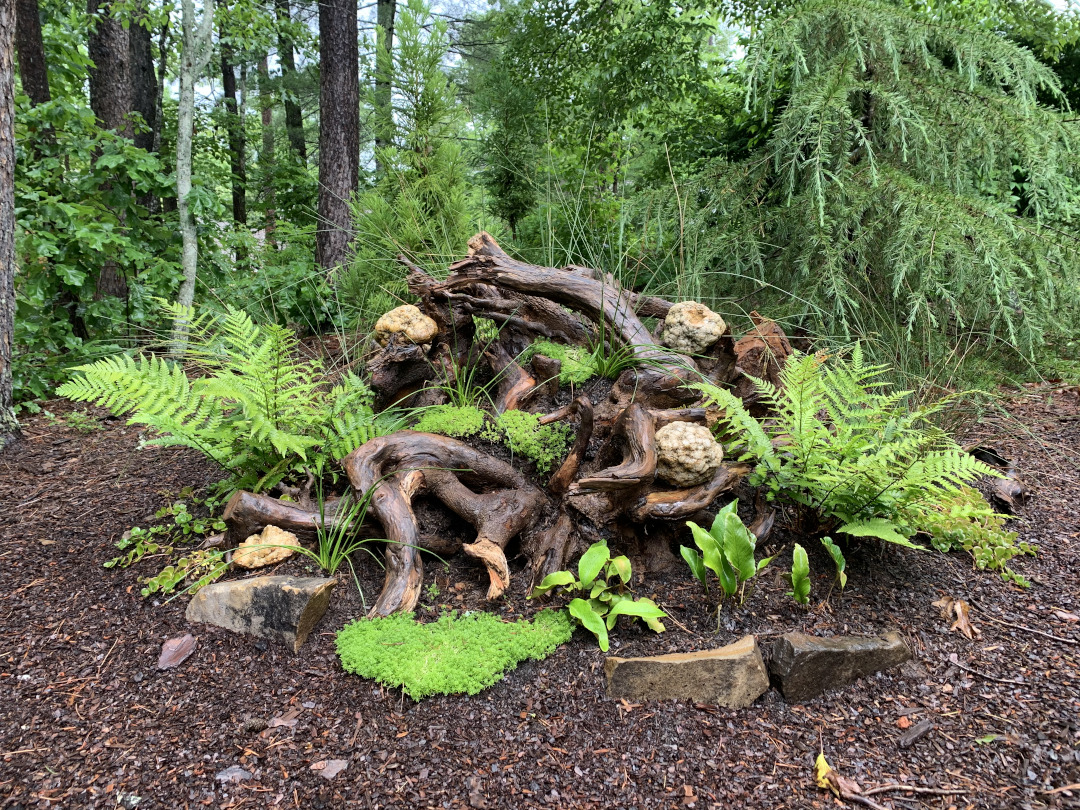 The stumpery was planted with evergreen plants taken from our garden. These include beautiful wood fern (Dryopteris pulcherrimal, Zones 6–9), tongue fern (Pyrrosia lingua, Zones 7–10), ‘Blue Arrows’ rush (Juncus inflexus ‘Blue Arrows’, Zones 5–9), white rain lily (Zephyranthes candida, Zones 7–10), moss stonecrop (Sedum acre, Zones 4–9), and ‘Coral Reef’ sedum (Sedum tetractinum ‘Coral Reef’, Zones 5–8). Three Indiana geodes are tucked among the roots to give added texture. The roots appear glossy from a drenching morning rain.
The stumpery was planted with evergreen plants taken from our garden. These include beautiful wood fern (Dryopteris pulcherrimal, Zones 6–9), tongue fern (Pyrrosia lingua, Zones 7–10), ‘Blue Arrows’ rush (Juncus inflexus ‘Blue Arrows’, Zones 5–9), white rain lily (Zephyranthes candida, Zones 7–10), moss stonecrop (Sedum acre, Zones 4–9), and ‘Coral Reef’ sedum (Sedum tetractinum ‘Coral Reef’, Zones 5–8). Three Indiana geodes are tucked among the roots to give added texture. The roots appear glossy from a drenching morning rain.
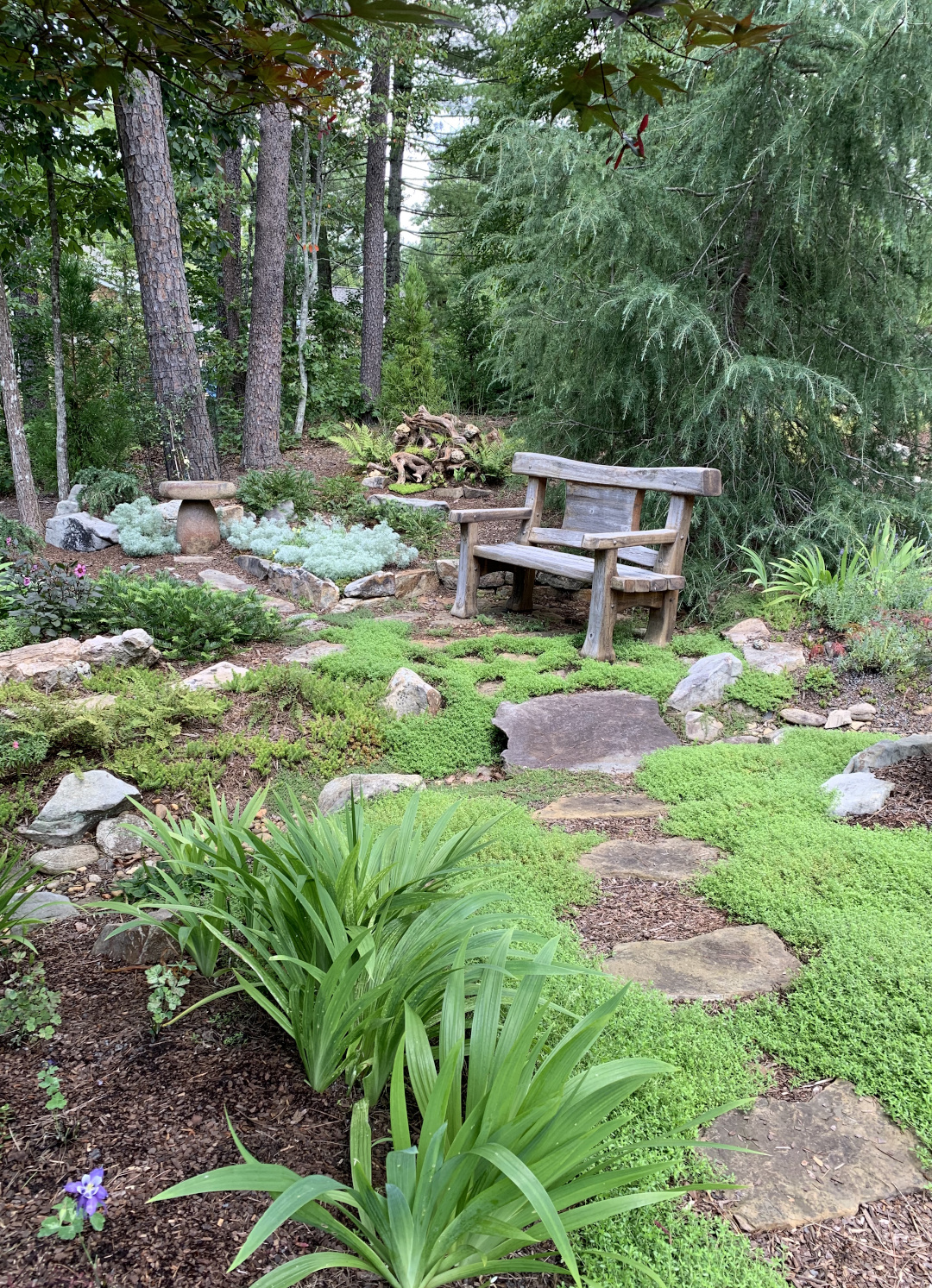 This photo gives a view of our ‘kitchen garden’ that houses the abstract stumpery. We call it the kitchen garden because it is the view from the bank of windows at our kitchen sink. This garden gives us hours of viewing pleasure as we go through the day. The prominent plants in this area are Japanese roof iris (Iris tectorum, Zones 4–9), ‘Archer’s Gold’ thyme (Thymus citriodorus ‘Archers Gold’, Zones 5–9), wormwood (Artemisia schmidtiana ‘Silver Mound’, Zones 4–9), spreading yew (Cephalotaxus harringtonii ‘Prostrata’, Zones 6–9), and deodar cedar (Cedrus deodara, Zones 7–9). The bench design was inspired by a Japanese timber bench and was handcrafted by a local master woodworker. The birdbath was created from natural granite boulders.
This photo gives a view of our ‘kitchen garden’ that houses the abstract stumpery. We call it the kitchen garden because it is the view from the bank of windows at our kitchen sink. This garden gives us hours of viewing pleasure as we go through the day. The prominent plants in this area are Japanese roof iris (Iris tectorum, Zones 4–9), ‘Archer’s Gold’ thyme (Thymus citriodorus ‘Archers Gold’, Zones 5–9), wormwood (Artemisia schmidtiana ‘Silver Mound’, Zones 4–9), spreading yew (Cephalotaxus harringtonii ‘Prostrata’, Zones 6–9), and deodar cedar (Cedrus deodara, Zones 7–9). The bench design was inspired by a Japanese timber bench and was handcrafted by a local master woodworker. The birdbath was created from natural granite boulders.
Have a garden you’d like to share?
Have photos to share? We’d love to see your garden, a particular collection of plants you love, or a wonderful garden you had the chance to visit!
To submit, send 5-10 photos to [email protected] along with some information about the plants in the pictures and where you took the photos. We’d love to hear where you are located, how long you’ve been gardening, successes you are proud of, failures you learned from, hopes for the future, favorite plants, or funny stories from your garden.
If you want to send photos in separate emails to the GPOD email box that is just fine.
Have a mobile phone? Tag your photos on Facebook, Instagram or Twitter with #FineGardening!
You don’t have to be a professional garden photographer – check out our garden photography tips!
Do you receive the GPOD by email yet? Sign up here.


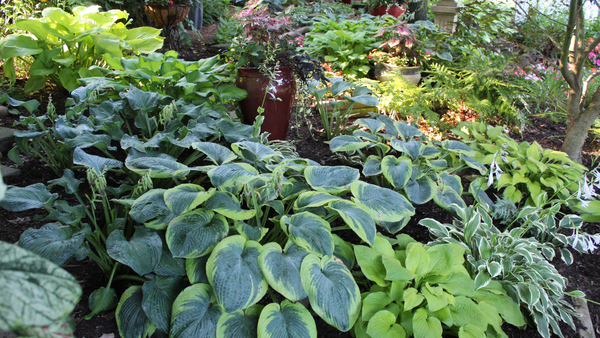


















Comments
Absolutely lovely! Worthy of any public botanical garden . . . and you created it in your backyard! So wonderful!!
Great idea! Looks great!
Delightful sharing and very inspiring. I love all the opportunities for personal creativity stump gardening provides. You've done a masterful job.
This is just so creative...and beautiful as well. What a wonderful way to use things that would probably be buried or burned in other locales. Truly inspirational!
I've considered a stump/root garden feature for a long time but was concerned about termites. When I first moved in to my home a previous owner had used stumps to outline an area in my yard and one spring I noticed swarms of termites flying off from the stumps.
Does anyone have experience with this occurring with root balls set up for decoration like the ones in this article?
Kudos to Bonnie for sharing these gardens filled with creativity inspiring ideas. Each space is quite distinct and the botanical choices are as varied as the arrangements of wood structures repurposed to be the framework.
Substantial downed tree limbs can also be harvested to form woodland bed edging, with soil built up on the planted side.
You've done some beautiful woodsy gardening with stumps, old wood and ferns! I love the way they attract the fungus and moss- so interesting- I saved some of your photos for inspiration!
So creative and lovely!
Bonnie - what an accomplishment! Thank you for sharing. I enjoyed looking at all the photos.
One year in Missouri I was a volunteer tour guide and took children on tours through a wooded area... logs figured prominently... I'll always remember seeing my first skink basking on a log.
As you pointed out, your stumpery fungi - so impressive!
And that bench! Perfect for the location.
Wow - I now have as bad a case of garden envy as I've ever experienced. Your garden with the stumperies is absolutely gorgeous and has started creative juices flowing here in NC! Thank you so much for sharing this!
Just beautiful. They do break down after awhile. But set in a woodland garden they can do that and still look lovely despite their inevitable demise. We had a huge tree taken down (hollow all the way to the ground). It was set in full sun and so I planted it out with zinnias and nasturtiums with other plantings around the base. It made a really nice accent piece above the patio. After a couple of years the bark began to fall off and in subsequent years the interior walls began to deteriorate. I had planned to just go with the flow and plant around it until it could be covered over with soil and a bed begun anew. Last year we had basement waterproofing done and it was all swept away when they put in (or rather took out) that area for a swale to direct runoff. So I didn't get to see the full cycle.
I guess that's what always happens with garden plans although this was more dramatic and quick than most.
Thank you for your comment.
Part of the beauty of a Stumpery is that it is a living sculpture. It will disintegrate over time which makes it even more interesting.
Bonnie
So "earthy" and lovely. Thank you for sharing your garden!
Truly beautiful!! We have also incorporated roots and limbs in our garden and love them. One we have stained to try to keep it around a little longer...
Your garden is absolutely enchanting. As one gardener to another, I would caution you about the euonymous fortunei. I planted one years ago ( I don't know if it was the Kiwensis) and although we removed the clump when it started to grow into a nearby tree, we are still fighting it years later. I live in zone 7b in north Alabama. If your plant starts producing berries, beware, because the birds will carry them far and wide. I consider that plant to be one of my biggest gardening mistakes so far.
Your point is well taken. In our garden the Kewensis variety of Wintercreeper is very slow growing and has never bloomed. I will certainly keep an eye on it though!
What amazing additions to gardens these stumperies provide! While I am using old logs or root tangles in three of my beds, I never thought of composing them to create such wonderful focal points as these. Regarding termites, they are, of course, part of the normal decomposition of wood. They do need moisture daily, and tend to avoid wood like cedar, Osage orange, black locust and sassafras. The very oldest log I have, covered with moss, is cedar, and has no evidence of termites. It has been horizontal for over 30 years, but only the base is in contact with the soil. Hope this is helpful.
Ingenious.
Simply fabulous!!! How creative!!! You make me love nature even more!!!
I love green environment. I often go to basket random to take care of and water the plants in my spare time.
Log in or create an account to post a comment.
Sign up Log in